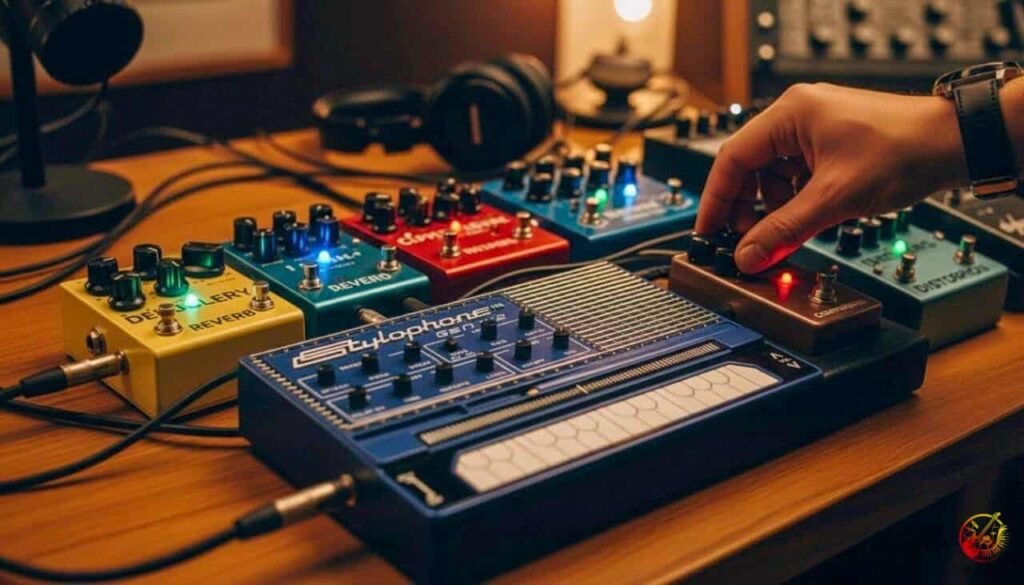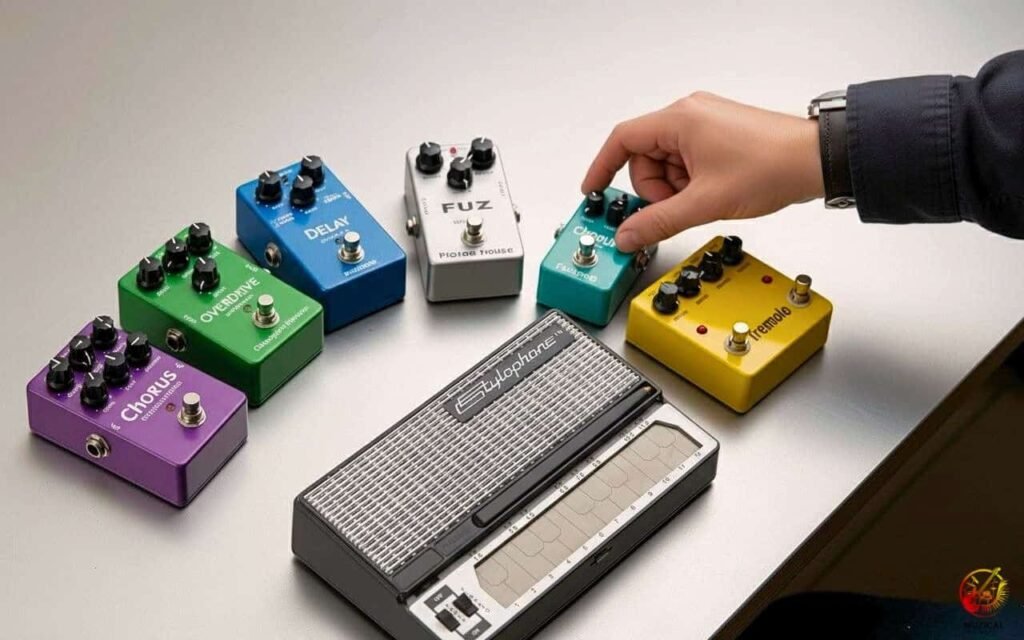Can I Use Pedals with Stylophone? Your Guide to a Universe of New Sounds
You can use pedals with Stylophone to make amazing sounds. This small electronic instrument works great with guitar effects. When you put a Stylophone through a phaser and delay pedal, it makes a huge, growling sound that will blow your mind.
Brian Jarvis made the first Stylophone in 1967. The company Dubreq has sold over three million of these pocket synthesizers. Famous musicians like David Bowie, Kraftwerk, and John Lennon used them on their records. Now musicians are finding out that running this little synth through effects pedals creates cool sounds.
This guide shows you how to connect your Stylophone to effects pedals. You’ll learn which cables you need and what types of pedals work best. We’ll also talk about volume levels and how to avoid problems when setting everything up.
What Kind of Output Does My Stylophone Have?

Most Stylophone models have a small headphone jack for sound output. This is a 3.5mm jack, just like the one on your phone or MP3 player. The new Stylophone S1 uses this same type of connector. The Gen X-1 model had the same setup before Dubreq stopped making it.
This small jack creates a challenge when you want to connect to guitar pedals. Most guitar effects use bigger 1/4-inch jacks. The sound from your Stylophone’s headphone output is also louder than what guitar pedals expect. This means you need to be careful about connections and volume levels.
The old Stylophone models from the 1970s had similar small outputs. But their inside parts work a bit differently than new ones. Knowing which model you have helps you pick the best way to connect effects.
How Do I Connect Pedals with Stylophone?
You need a cable adapter to connect your Stylophone to guitar pedals. The easiest way is to get a 3.5mm to 1/4-inch adapter. You can buy these at any music store for about $5 to $15.
Ways to Connect:
| Connection Type | Best For | Sound Quality | Cost |
|---|---|---|---|
| Simple adapter | Testing one pedal | Good | $5-15 |
| Adapter cable | Regular use | Better | $10-25 |
| DI box | Recording | Best | $40-120 |
Start with a basic adapter to test how your pedals sound with the Stylophone. Just plug the adapter into your Stylophone’s headphone jack, then plug your effect pedal into the adapter. Turn your pedal’s input volume down at first to avoid loud, harsh sounds.
For playing live or recording, get a proper adapter cable instead of just a small plug. Cables stay connected better and have less noise. Look for ones with good shielding to keep your sound clean.
Which Effects Work Best with Stylophone?
Time based effects like delay and reverb work great when you use pedals with Stylophone. Many musicians say you should try plugging it into your effects pedals because the results sound amazing.

Best Types of Effects
Chorus, Phaser, and Flanger: These effects make the Stylophone sound bigger and more interesting. The simple electronic sound works really well with these moving effects. You can get anything from gentle movement to wild swooshing sounds.
Delay and Reverb: These effects make the Stylophone sound huge. Short delays make the sound thicker. Longer delays with feedback create space sounds and rhythmic patterns. One user says to “add lots of reverb to go to outer space.”
Distortion and Fuzz: These can make your Stylophone sound mean and aggressive. But be careful, the Stylophone puts out a strong signal that can overload distortion pedals. Start with low settings and turn up slowly.
| Effect Type | Good Settings | What It Does |
|---|---|---|
| Chorus | Slow speed, medium depth | Makes vintage synth sounds |
| Delay | 250-500ms timing | Creates rhythms and space |
| Reverb | Hall sound, long decay | Makes big atmospheric sounds |
| Phaser | Medium speed, deep sweep | Creates movement and retro sounds |
Can I Use Multiple Pedals with Stylophone?
Yes, you can chain several pedals together with your Stylophone. Using pedals with Stylophone in a row often sounds better than just one effect. The trick is putting them in the right order and watching your volume levels.
Best Order for Effects:
- Volume Control: DI box or volume pedal first if needed
- Movement Effects: Chorus, phaser, flanger go early
- Distortion: Overdrive or fuzz in the middle
- Space Effects: Delay and reverb go last
When you connect many pedals, each one might make the signal a bit louder. Too many pedals can make later ones sound bad or distorted. Use the bypass switches to compare your clean Stylophone sound with the effects.
You can also split your Stylophone signal to go to different effects at the same time. This lets you mix clean and effected sounds together. It creates layered textures while keeping things clear.
What Volume Problems Should I Know About?
Volume control is the biggest challenge when using pedals with Stylophone. The headphone output is much louder than what guitar pedals expect. This can cause harsh, distorted sounds even when your effects are set clean.
Common Problems:
- Too Loud: Harsh sounds even with clean settings
- Less Control: Hard to get subtle effects
- Bad Connections: Tone changes or weak signal
- Noise: Buzzing or humming sounds
A DI box with volume control fixes most of these problems. Many audio interfaces also have special inputs for electronic instruments like the Stylophone.
Quick Fix: If your effects sound bad or distorted, turn down the Stylophone’s volume knob before it goes into the effects. This keeps good sound quality while preventing problems.
Are Digital Effects Better for Stylophones?
Modern digital effects often work better than old analog pedals when you use pedals with Stylophone. New effects units have special inputs that handle electronic instruments better. They also adjust volume levels automatically.
Digital effects can do things that regular guitar pedals can’t. You can change pitch, add harmony, and create complex sounds that work great with the Stylophone’s steady electronic signal. Some effects can completely change the simple Stylophone sound into complex, moving textures.
Digital Effect Benefits:
- Multi-effects: Many effects in one box
- Computer Connection: Record directly into your computer
- Phone Apps: Use your phone for effects with the right adapters
- Samplers: Record and change Stylophone sounds
If you use digital effects while playing, watch out for delay in the sound. Some complex effects make the sound come out a bit late, which can feel weird when you’re playing.
Can I Record Stylophone Through Pedals?
Yes, recording your Stylophone with effects is easy with the right setup. The Stylophone sounds much better when connected to an amp or sound system, and this works the same way for recording.
For home recording, connect your effects to your audio interface’s line input. You can also use a DI box if you only have guitar inputs. Many musicians record both the clean Stylophone and the effects version at the same time. This gives you more choices when mixing later.
Professional studios often use the Stylophone as a unique texture. The processed sound adds character that’s hard to get with computer synths alone.
Final Thoughts
Using pedals with Stylophone opens up many new sound possibilities. This pocket synthesizer, created by Brian Jarvis in 1967, has stayed popular for over 50 years because of its unique character.
With the right cables, proper volume control, and good effects choices, you can turn your handheld synthesizer into a powerful sound tool. Delay and reverb effects, chorus and phaser effects, and careful distortion can change your sound from simple to amazing.
Start with one pedal to learn how your Stylophone works with effects. Add more pedals slowly, watching your volume levels. Most importantly, try different combinations, the Stylophone’s unique voice often creates surprising and musical results.
Ready to expand your sounds? Get a 3.5mm to 1/4-inch adapter and a delay pedal to start. When you use pedals with Stylophone the right way, this little synthesizer might become your favorite music tool.
FAQ: Can I Use Pedals with Stylophone?
1. Can you plug a Stylophone directly into an amplifier?
Yes, absolutely. You can connect a Stylophone directly to a guitar amplifier, a keyboard amp, or a PA system. You will need a cable with a 3.5mm (1/8-inch) plug for the Stylophone’s headphone output and a 1/4-inch plug for the amplifier’s input. This simple connection allows you to make your Stylophone much louder for performance or practice.
2. How do you get different sounds from a Stylophone?
The most effective way to get different sounds is by using pedals with your Stylophone. Effect pedals like delay, reverb, fuzz, and chorus can completely transform the instrument’s basic tone. For example, a reverb pedal can make it sound vast and atmospheric, while a distortion pedal can turn it into a gritty lead instrument. The Stylophone Gen X-1 model also has built-in sound-shaping controls like a filter, LFO, and sub-oscillator.
3. What is the output of a Stylophone?
The standard audio output on almost all Stylophone models is a 3.5mm (1/8-inch) headphone jack. This output provides a line-level, mono audio signal. This standard connection makes it easy to plug into headphones, mixers, audio interfaces for recording, and effect pedals.
4. Can you record a Stylophone on a computer?
Yes, you can easily record a Stylophone. The most common method is to connect the Stylophone’s 3.5mm output to the input of an audio interface using a 3.5mm to 1/4-inch cable. The audio interface then connects to your computer via USB, allowing you to record the sound directly into your preferred Digital Audio Workstation (DAW) like Ableton Live, Logic Pro, or GarageBand.
5. Do you need a special cable to connect a Stylophone to pedals?
You don’t need a “special” cable, but you do need the correct one. The essential cable is a 3.5mm male to 1/4-inch male mono (TS) audio cable. The smaller 3.5mm end fits the Stylophone’s headphone jack, and the larger 1/4-inch end fits the standard input jack on virtually all guitar and synth pedals.
6. Is the Stylophone a real instrument?
Yes, the Stylophone is considered a real musical instrument, specifically a miniature analog synthesizer. While its simple interface makes it accessible and fun, it has been used in professional recordings by iconic artists like David Bowie, Kraftwerk, and The White Stripes. When combined with modern production techniques and effect pedals, it becomes a surprisingly versatile tool for sound design and music creation.
7. Do guitar pedals work with synthesizers?
Yes, guitar pedals work exceptionally well with synthesizers, including the Stylophone. Since both guitars and synths produce an electronic audio signal, they can be processed with the same effects. Using guitar pedals with a Stylophone or any other synth is a popular technique for adding character, texture, and depth to electronic sounds.
